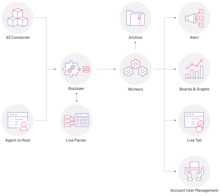LogDNA
LogDNA is a technology company located in Silicon Valley, California[1]. Their log management solution enables DevOps teams to aggregate all of their system and application logs into a single platform. Automatic parsing, natural language search, and real-time alerts allow teams to develop and debug their applications[2].
 | |
| Private | |
| Industry | Enterprise software |
| Founded | 2015 |
| Founders | Christopher Nguyen, Lee Liu |
| Headquarters | Mountain View, California, United States |
| Services | Log Management and Intelligence, Log Analysis |
| Website | www |
LogDNA
History
The company was founded by Chris Nguyen and Lee Liu in 2016 after participating in Y Combinator’s Winter 2015 batch [3]. They have raised a total of $33.4 million in funding over four rounds through investments from Y Combinator, Initialized Capital, Emergence Capital Partners, Providence Equity Partners, Oyster Ventures, and Proton Enterprises [4]. Their latest funding was a Series B round announced on December 11, 2018. In January 2020, the executive team expanded to include Tucker Callaway as President and CRO of the company [5]. Prior to joining LogDNA, he served as CRO for Sauce Labs and VP of Enterprise Sales for Chef Software [6].
Technology
LogDNA provides a SaaS-based log management service that helps centralize logs from all applications, servers, platforms and systems into a web viewer. Features include smart parsing and intelligent filters, and it works with any infrastructure and architecture, supporting numerous platforms and ingestion methods, including syslog, code libraries, the LogDNA open-source agent, AWS, Google Cloud, and more [7].
Kubernetes
LogDNA is built on Kubernetes and optimized for Kubernetes log management. Users can get up and running with just two kubectl commands and collect logs from all of their containers [8]. Their offerings on IBM Cloud help users configure cluster-level logging in IBM Cloud Kubernetes Service [9]. LogDNA employees have spoken at conferences such as KubeCon [10] and Container World [11] and contributed articles to The New Stack [12] about Kubernetes.
Supported Ingestion Sources[13]
1. Syslog 2. Code libraries 3. LogDNA open-source agent 4. AWS 5. GCP 6. Ingestion REST API 7. Kubernetes 8. Kibana 9. Docker 10. Fluentd 11. Flynn 12. Amazon Cloudwatch 13. Amazon Elastic Beanstalk 14. Cloud Foundry 15. Akamai 16. Aptible 17. OpenShift 18. Linux Debian-Based
a. Ubuntu b. Debain c. Linuxmint
19. Linux RPM-Based
a. Redhat Enterprise Linux b. CentOS c. Amazon Linux
20. Other OS
a. Linux Gentoo b. Windows c. OS X Server
21. Language
a. Rest API b. Node.js c. Ruby/Rails d. Python e. Go Lang f. Java g. PHP h. iOS
Integrations[14]
1. Node.js 2. Node.js Bunyan 3. Node.js Winston 4. Code Library: Python 5. Code Library: Ruby 6. Code Library: Rails 7. Fluentd 8. AWS CloudWatch 9. AWS ELB 10. LogSpout 11. CloudFoundry 12. GitHub - Webhook / backend 13. Aptible - Webhook / backend 14. Akamai - Webhook / backend 15. SaltStack - Webhook / backend 16. Stripe - Webhook / backend 17. Heroku - Webhook / backend 18. r-syslog 19. syslog 20. Syslog-ng 21. Java Community 22. Go Community 23. PHP Community 24. .NET Community 25. iOS Community
Features[15]
1. Views: Views are saved shortcuts to a set of filters and search queries. 2. Alerts: LogDNA integrates with many 3rd party solutions so users can receive alerts with other applications like PagerDuty, Slack, or another API. 3. Boards and Graphs: Users can visualize their system’s activity with LogDNA’s Boards and Graphs. Visualize log data over a time period to better analyze system activity and identify trends. 4. Screens: Screens display daily log activity from systems. Time-shifted graphs aggregate data from the previous week to compare activity levels to the current week.

Product Release Timeline
In April 2020, LogDNA announced the ability to store and show raw log lines and introduced the new LogDNA agent for Kubernetes, which is built on Rust, a low-level systems programming language that is fast, safe and extensible. [16]
In March 2020, LogDNA announced the general availability of the Extract and Aggregate fields feature to custom parse historical logs (post-ingestion) and create an aggregated count on those newly parsed fields.[17]
In February 2020, LogDNA announced custom webhooks enabling its users to receive alerts anywhere. The company already integrates with many third-party services including Slack, PagerDuty, and VictorOps.[18]
In January 2020, LogDNA announced a new lightweight S3 Collection. Included was improved parsing of AWS logs so that CloudFront and ELB/ALB logs are precisely parsed and searchable. This makes long ALB logs for instance much easier to understand and query.[19]
IBM Partnership
In 2018, LogDNA partnered with IBM to launch two observability offerings on IBM Cloud Kubernetes Service.[20] IBM Log Analysis with LogDNA is a log management solution that helps users gain detailed insights into their system and application logs.[21] IBM Cloud Activity Tracker with LogDNA tracks events from IBM Cloud services so that users have full visibility into their deployments.[22] Both offerings are available in the IBM Cloud Service Catalog. [23]
Awards and Recognition
In 2020, LogDNA won the IBM Cloud Embed Excellence Award[24] during the IBM Think 2020 conference and was named to the Enterprise Tech 30 list.[25] Also in 2020, LogDNA won the Spring G2 Crowd Best Software awards for the categories of Easiest Setup, Most Implementable, Momentum Leader and Best Usability. [26] In 2019, Forbes included LogDNA on its Cloud 100 Rising Stars list,[27] Upstart Tech named LogDNA its “Most Implementable” technology,[28] and LogDNA was included in Silicon Review’s Smartest 50 Companies of the Year list.[29]
External Links
-Website: logdna.com
-LinkedIn: linkedin.com/company/logdna
-Twitter: @logdna
-Facebook: facebook.com/logdna
-Instagram: @joinlogdna
References
- https://www.google.com/maps/place/LogDNA/@37.3929831,-122.0797291,15z/data=!4m5!3m4!1s0x0:0x23280353fc6c39cc!8m2!3d37.3929831!4d-122.0797291
- https://logdna.com/why-logdna/
- https://www.ycombinator.com/companies/?batch=w2015
- https://www.crunchbase.com/organization/logdna
- https://www.linkedin.com/in/tucker-callaway-9310171/
- https://www.crunchbase.com/person/tucker-callaway#section-jobs
- https://logdna.com/technology/
- https://logdna.com/kubernetes/
- https://cloud.ibm.com/docs/Log-Analysis-with-LogDNA?topic=Log-Analysis-with-LogDNA-kube
- https://www.youtube.com/watch?v=LLjbseYcjfY
- https://www.youtube.com/watch?v=3SqtHoRsyF8
- https://thenewstack.io/a-blueprint-for-running-stateful-services-on-kubernetes/
- https://logdna.com/technology/
- https://logdna.com/integrations/
- https://logdna.com/products/
- https://logdna.com/store-and-show-raw-log-lines/
- https://logdna.com/announcing-the-general-availability-of-extract-and-aggregate-fields/
- https://logdna.com/custom-webhooks/
- https://logdna.com/s3-bucket-lambda-function/
- https://www.ibm.com/cloud/blog/increase-observability-ibm-log-analysis-with-logdna-is-available-today-on-ibm-cloud
- https://cloud.ibm.com/catalog/services/ibm-log-analysis-with-logdna?callback=%2Fobserve%2Flogging%2Fcreate#about
- https://cloud.ibm.com/catalog/services/ibm-cloud-activity-tracker-with-logdna?callback=%2Fobserve%2Factivitytracker%2Fcreate#about
- https://cloud.ibm.com/catalog?category=devops#services
- https://www.ibm.com/blogs/business-partners/celebrating-our-2020-ibm-business-partner-award-winners/
- https://www.enterprisetech30.com/
- https://www.g2.com/products/logdna/reviews
- https://www.forbes.com/sites/kenrickcai/2019/09/11/the-cloud-100-rising-stars-2019-meet-the-20-up-and-comers-in-techs-hottest-category/#48590bd2ad4f
- https://www.bizjournals.com/sanjose/news/2019/10/29/upstart-tech-awards-silicon-valley-technology-out.html
- https://thesiliconreview.com/magazine/profile/50-smartest-companies-of-the-year-2019